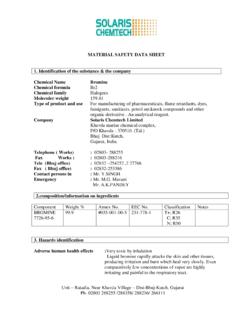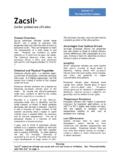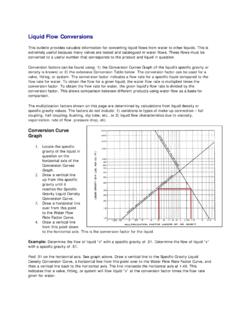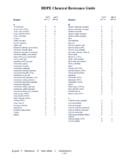Transcription of Potassium Amyl Xanthate (PAX) - Joyforce Chemical …
1 MATERIAL SAFETY DATA SHEET. Potassium Amyl Xanthate (PAX). SECTION 01 PRODUCT AND COMPANY INFORMATION. Product Name .. Potassium Amyl Xanthate Chemical Family .. Xanthates; carbonodithioic acid salt Synonyms .. Potassium amyl Xanthate ; PAX; carbonodithioic acid, 0-pentyl ester, Potassium salt; dithiocarbonic acid, 0-pentyl ester, Potassium salt, Potassium pentyl Xanthate . Formula .. C6H11 KOS2. Supplier Name .. Xiamen Joyforce Chemical Industrial Co., Ltd Address .. Building, Shuangli Industrial Park, Huli District, Xiamen 361009, China. Phone .. +86-592-586-4569. Fax .. +86-592-511-7592. E - mail .. SECTION 02 COMPOSITION. Chemical Ingredients (% by wt.). Cas Number Concentration Potassium amyl Xanthate CAS #:2720-73-2 20-30%. Water CAS #:7732-18-5 80% Max SECTION 03 HAZARDS IDENTIFICATION. EMERGENCY OVERVIEW. Caution: Liquid solution is strongly alkaline.
2 Eye contact will result in mild to severe eye irritation. Contact with the skin will result in mild to severe burns of the skin. Ingestion of product will irritate mouth, throat and gastrointestinal tract. Inhalation of product vapours, mist may cause irritation of respiratory airways. This product is listed as a HAZARDOUS material under criteria of NOHSC. This product is classified as DANGEROUS GOODS by the criteria of the ADG Code Hazard Category .. Corrosive Risk Phrases .. R21/22 Harmful in contact with skin & if swallowed R31 Contact with acids liberates toxic gas. R36/38 Irritating to eyes and skin. R48/20 Harmful: danger of serious damage to health by prolonged exposure through inhalation. Safety Phrases .. S1/2 Keep locked up and out of reach of children. S16 Keep away from sources of ignition No smoking. S33 Take precautionary measures against static discharges S36/37 Wear suitable protective clothing and gloves.
3 S45 In case of accident or if you feel unwell, contact a doctor or Poisons Information Centre Immediately (show label where possible). Revised: May 2010 : MSDS Xanthate Solution Page 1 of 5. MATERIAL SAFETY DATA SHEET. Potassium Amyl Xanthate (PAX). IMPORTANT NOTE REGARDING POSSIBLE PRESENCE OF CARBON DISULPHIDE (CS2). The freshly prepared Xanthate solution will contain low levels of carbon disulphide. This is formed by decomposition of some Xanthate molecules during dissolution of dry PAX. During storage of Xanthate solution there will be further decomposition of Xanthate molecules producing yielding increasing levels of carbon disulphide in the solution. The rate of decomposition depends on factors such as the temperature of the solution and the presence of other elements and molecules. Because it is a highly volatile liquid, carbon disulphide present in Xanthate solution will produce carbon disulphide vapour which is toxic and extremely flammable (Flash Point -30oC).
4 If the freshly supplied Xanthate solution is to be stored for more than 5 days the presence of carbon disulphide becomes an important consideration in the safe storage and handling of the solution and the MSDS for carbon disulphide should be consulted for guidance. SECTION 04 FIRST AID MEASURES. Ingestion .. If victim is conscious, have victim rinse mouth thoroughly with water. DO NOT. INDUCE VOMITING. Have victim drink a glass of water. If vomiting occurs naturally, have victim lean forward to avoid aspiration. Repeat administration of water. Obtain immediate medical attention. Eye .. Immediately flush with large quantities of water for 15 minutes. Hold eyelids apart during irrigation to insure thorough flushing of the entire area of the eye. Obtain immediate medical attention. Skin .. Immediately flush with large quantities of water. Remove contaminated clothing under a safety shower.
5 Obtain medical attention if any irritation occurs. Inhalation .. Remove victim from contaminated atmosphere. If breathing is laboured, administer oxygen. If breathing has ceased, clear airway and start mouth to mouth resuscitation. If heart has stopped beating, external heart massage should be applied. Obtain medical attention. SECTION 05 FIRE FIGHTING MEASURES. Keep storage containers involved in a fire cooled with water spray. Heating will form flammable CS2 vapours Flammability .. Xanthate solutions are not flammable substances. They do decompose to form flammable compounds such as highly flammable carbon disulphide and alcohol. Extinguishing Media .. Use water to extinguish flames. Do not allow water run-off to enter sewers or waterways. Fire fighting procedures .. As in any fire, wear self-contained breathing apparatus, positive pressure, full protective gear & apparatus which supplies a positive air pressure within a full face- piece mask.
6 Fire explosion hazard .. Xanthate solution upon aging, heating or exposure to acids will generate carbon disulfide (CS2) vapours. Storage containers should be equipped with a forced exhaust to prevent build-up of these vapours. Storage containers should be carefully grounded. Flammable Properties .. Non-flammable solution which may release carbon disulphide. Flash Point: -22 F (-30 C) Carbon disulfide (CS2) Method Used: Closed cup Flammable Limits (Carbon disulfide) LFL: UFL: 50%. Revised: May 2010 : MSDS Xanthate Solution Page 2 of 5. MATERIAL SAFETY DATA SHEET. Potassium Amyl Xanthate (PAX). SECTION 06 ACCIDENTAL RELEASE MEASURES. Large releases: .. Confine area to qualified personnel. Extinguish or remove all ignition sources. Shut off release if safe to do so. Dike spill area to prevent runoff into sewers, drains or surface waterways (potential aquatic toxicity).
7 Recover as much of the solution as possible. Treat remaining material as a small release. Handling: .. Avoid contact with eyes. Use only in a well ventilated area. Wash thoroughly after handling. Avoid prolonged or repeated breathing of vapours. Avoid prolonged or repeated contact with the skin. Ground drums and bond transfer containers (grounding clips must contact bare metal). (See Section 5, for fire dangers). Use caution opening containers with xanthates of unknown age ( CS2 vapour accumulation). SECTION 07 HANDLING & STORAGE. Storage .. Store in cool, dry, well ventilated areas. Do not store combustibles in the area of storage vessels. Keep away from any sources of heat or flame. Store tote and smaller containers out of direct sunlight at moderate temperatures. Storage containers should be properly grounded. (See Section 10 for materials of construction).
8 Handling .. Avoid contact with eyes. Use only in a well ventilated area. Wash thoroughly after handling. Avoid prolonged or repeated breathing of vapours. Avoid prolonged or repeated contact with the skin. SECTION 08 PERSONAL PROTECTION AND EXPOSURE CONTROLS. Maintain an eyewash/safety shower in immediate work areas. Skin Protection: .. Neoprene rubber gloves, apron and boots (as appropriate) should be worn to prevent repeated or prolonged contact with the liquid. Wash any contaminated clothing prior to reuse. Eye Protection: .. Chemical goggles and preferably a full face shield. Respiratory Protection .. Use in well ventilated areas. If conditions exist where mist may be generated, an approved mist respirator should be worn. If CS2 vapours are present wear a Type A. (Organic Vapour) Respirator. Ventilation .. Do not inhale. Use in well ventilated areas.
9 In poorly ventilated areas, mechanical explosion proof extraction ventilation is recommended. Flammable/explosive vapours may accumulate in poorly ventilated areas. Vapours are heavier than air and may travel some distance to an ignition source and flash back. Maintain vapour levels below the recommended exposure standard. Exposure Guidelines: TWA IDLH(Inhalation) TCLo (inhalation) LCLo (inhalation). Carbon disulfide (evolved) 10 ppm 500ppm 40 mg/m3 (man) 2000ppm / 5 minutes (human). SECTION 09 PHYSICAL AND Chemical PROPERTIES. Appearance:.. Yellow liquid. Odour: .. Strong organic odour Boiling Point: .. >100 C. Solubility in Water: .. Complete Specific Gravity: .. (200 300g/Litre). Revised: May 2010 : MSDS Xanthate Solution Page 3 of 5. MATERIAL SAFETY DATA SHEET. Potassium Amyl Xanthate (PAX). Ph: .. SECTION 10 STABILITY AND REACTIVITY. Stability.
10 PAX solutions are relatively stable if they are kept cool and the pH is maintained within an acceptable range. Under certain conditions, Potassium amyl Xanthate decomposes to very toxic and extremely flammable carbon disulfide. The rate of carbon disulfide generation from solution increases with temperature, pH below 8 (becoming rapid below pH 7; acidic conditions) or pH greater than 13, as well as with time (aging of the solution). Maximum stability of solutions is attained at a pH of approximately 10. Hazardous Polymerization: .. Does not occur Hazardous Decomposition Products: .. Decomposition products in water include carbon disulfide, trithiocarbonate, pentanol, Potassium carbonate. Incompatibility: .. Acids or Acidic solutions the hydrolysis of Xanthate solutions, which produces carbon disulfide, is accelerated by acidic pH (less than 8).






